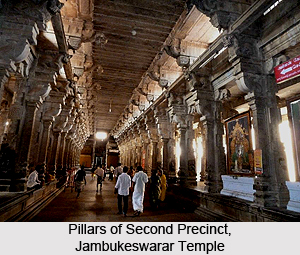 Architecture of Jambukeswarar Temple in Tiruchirapally, Tamil Nadu bears a sharp resemblance to the Srirangam Ranganathaswamy Temple which was one of its contemporary temples, though historians claim that its architectural grandeur beats that of the latter. Erected about 1, 800 years ago, Jambukeswarar Temple contains five enclosures within its premises. The temple was constructed by the king Kochenga Chola, following the style of Dravidian architecture, and is amongst the Panchabhoota Sthalams.
Architecture of Jambukeswarar Temple in Tiruchirapally, Tamil Nadu bears a sharp resemblance to the Srirangam Ranganathaswamy Temple which was one of its contemporary temples, though historians claim that its architectural grandeur beats that of the latter. Erected about 1, 800 years ago, Jambukeswarar Temple contains five enclosures within its premises. The temple was constructed by the king Kochenga Chola, following the style of Dravidian architecture, and is amongst the Panchabhoota Sthalams.
`Vibudi Prakara` is the giant external wall which surrounds the fifth temple precinct and it continues to stretch above a mile, with a height of 25 feet and width of two feet. As per a Hindu legend, this wall was created by Lord Shiva, who toiled along with some labourers. Measuring about 2436 feet by 1493 feet, the fourth precinct possesses a hall with 796 pillars. Perennial springs feed the tiny tank present here. The third temple precinct is fortified with a 30 feet high wall and measures about 745 feet by 197 feet. Two `gopurams` are existent, one of which is 100 feet in height while the other is 73 feet in height. A small water tank and a coconut `thoppu` is also there. The second temple enclosure has a gopuram which is 65 feet in height, measures nearly 306 feet by 197 feet and also consists of numerous tiny shrines. The sanctum sanctorum exists inside the innermost enclosure which measures about 126 feet by 123 feet.
Present at the central portion of the innermost enclosure of Jambukeswarar Temple, the `garbhagriha` is square-shaped. Its terrace has a `vimana` and is open on all three sides, being separated from the circumambulatory strip of land by a small moat. Close to the sanctum sanctorum grows the sacred tree or `sthala-vriksham`, particularly alongside the south-eastern wall of the sanctum. A walled structure defends the tree trunk and a gigantic closed hall or `Mukha Mandapa` possessing four pillars and a bronze idol of Nandi are also present in the western portion of the sanctum sanctorum. The main entrance of the temple is marked by a huge, ornamental, western door embedded with silver. The Mukha Mandapa can also be accessed by two other entrances on the north-eastern and southern end as well.
Visitors will notice a series of three stairs leading downwards to the garbhagriha from the Mukha Mandapa and will be able to catch sight of the deity with the aide of a stone window. Nine apertures arm the window, which symbolises the `Navagraha` and the `Sthala Puranam` is represented by the panelled bas-relief on the window. The image of an elephant and spider worshipping the Shiva Lingam and Parvati standing to the left side of the lingam, the lingam of Jambukeswarar and the Jambuka tree emerging out from the head of a meditating sage are existent inside the temple.
The `Antaralam` or `Ardha Mantapam` and garbhagriha divide the sanctum sanctorum and it is here that Jambukeswarar deity is existent. The sanctum can be approached with the help of a tiny door which measures 4 feet in height, on the southern wall. An idol of Goddess Parvati is there inside the Ardha Mantapa, near the right side of the garbhagriha door. During festive events like `Abhishekam`, pilgrims are permitted to enter the temple in groups of six, against a small payment. Compared to the Ardha Mabtapa, the garbhagriha is much wider and its central part contains the `Brahma Sthana`, which is the self-erected linga of Jambukeswarar.
The pedestal or `yoni bhaga` of the Shiva Lingam is composed of black granite while the upper conical region of the lingam is of copper colour. The point of intersection of the lingam and pedestal contains a brass ring and the lingam measures about 3 feet in height. The light from ghee lamps are the only source of illumination of the Ardha Mantapa and also the garbhagriha. The lingam is believed to sprout streams of water which is testified by the wet garments that are draped around it. During monsoons, the flow enhances. The element of water is depicted by the principal temple deity of Jambukeswara. Jambukeswara is portrayed as being seated underneath a Jambu tree which grows a tiny stream in which the deity submerges during the monsoons. It is believed that Goddess Akilandeswari, who is one of the divine avatars of Parvati, is another deity of the temple.





















